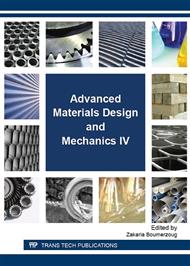[1]
S. Bruschi, T. Altan, D. Banabic, et al, Testing and modeling of material behavior and formability in sheet metal forming, J. CIRP Annals-Manufacturing Technology. 63 (2014) 727-749.
DOI: 10.1016/j.cirp.2014.05.005
Google Scholar
[2]
J.H. Sung, J.H. Kim, R.H. Wagoner, A plastic constitutive equation incorporating strain, strain-rate, and temperature, J. International Journal of Plasticity. 26 (2010) 1746-1771.
DOI: 10.1016/j.ijplas.2010.02.005
Google Scholar
[3]
G.R. Johnson, W.H. Cook, A constitutive model and data for metals subjected to large strain high strain rates and high temperatures, C. Proceedings of the Seventh International Symposium on Ballistic. (1983), 541-547.
Google Scholar
[4]
T.J. Holmquist, G.R. Johnson, Evaluation of cylinder impact test data for constitutive model constants, J. Journal of Applied physical. 64 (1998) 3901-3910.
DOI: 10.1063/1.341344
Google Scholar
[5]
W.K. Rule, S.E. Jones, A revised form for the Johnson-Cook strength model, J. Int.J. Impact. Engng. 8 (1998) 609-624.
Google Scholar
[6]
U. Andrade, M.A. Meyers, A H. Chokshi, Constitutive description of work-and shock-hardened copper, J. Scripta Metall Mater. (1994) 933-938.
DOI: 10.1016/0956-716x(94)90418-9
Google Scholar
[7]
F. J Zerilli, and R.W. Armstrong, Dislocation-mechanics-based constitutive relations for material dynamics calculations,J. Appl. phys. 61 (1987) 1816-1825.
DOI: 10.1063/1.338024
Google Scholar
[8]
D.J. Steinberg, C.M. Lund, A constitutive model for strain rates from 10-4s-1 to 106s-1, J. J. Appl. Phys. 65(1989) 1528-1533.
Google Scholar
[9]
D.J. Steinberg, A rate-dependent constitutive model for molybdenum ,J.J. Appl. Phys. 74(1993) 3827-3831.
DOI: 10.1063/1.355316
Google Scholar
[10]
W .H. Holt, W . Jr. Mock, F. L. Zerilli. and J. B. Clark, Experimental and computational study of the impact deformation of titanium Taylor cylinder specimens, J. Mechanics of Materials. 17 (1994)195-201.
DOI: 10.1016/0167-6636(94)90059-0
Google Scholar


